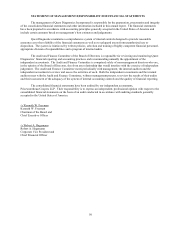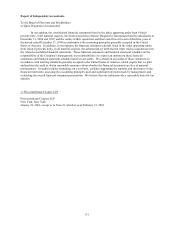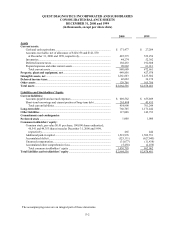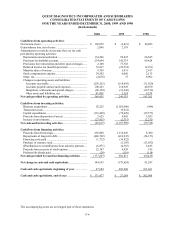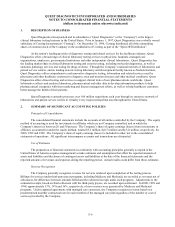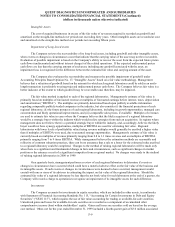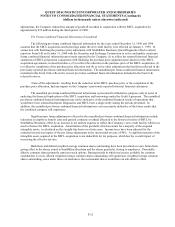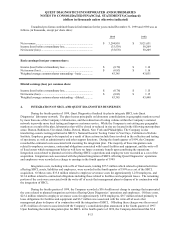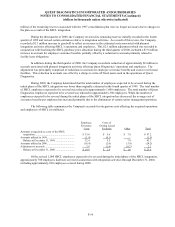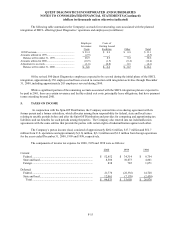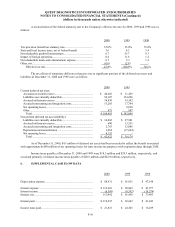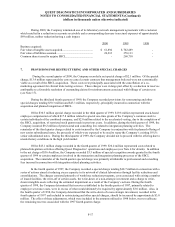Quest Diagnostics 2000 Annual Report Download - page 80
Download and view the complete annual report
Please find page 80 of the 2000 Quest Diagnostics annual report below. You can navigate through the pages in the report by either clicking on the pages listed below, or by using the keyword search tool below to find specific information within the annual report.QUEST DIAGNOSTICS INCORPORATED AND SUBSIDIARIES
NOTES TO CONSOLIDATED FINANCIAL STATEMENTS (Continued)
(dollars in thousands unless otherwise indicated)
F-10
with the sale of an investment. The proceeds from the sale of $7.7 million were classified as a component within the
change in investments in the statement of cash flows for 1999. Investments in equity securities have not been material to
the Company.
Financial Instruments
The Company’s policy is to use financial instruments only to manage exposure to market risks. The Company
has established a control environment that includes policies and procedures for risk assessment and the approval,
reporting and monitoring of derivative financial instrument activities. These policies prohibit holding or issuing
derivative financial instruments for trading purposes.
The Company defers the impact of changes in the market value of these contracts until such time as the hedged
transaction is completed. The Company may also, from time to time, enter into interest rate and foreign currency swaps
to manage interest rates and foreign currency risk. Income and expense related to interest rate swaps is accrued as
interest rates change and is recognized in earnings over the life of the agreement. Gains or losses realized and premiums
paid on foreign currency contracts are deferred and are recognized as payments are made on the related foreign currency
denominated debt, or immediately if the obligation instrument is settled.
During 2000 and 1999, the Company entered into interest rate swap agreements to mitigate the risk of changes
in interest rates associated with its variable rate bank debt in accordance with the terms of the Company’s credit
agreement (see Note 12).
In June 1998, the Financial Accounting Standards Board (“FASB”) issued Statement of Financial Accounting
Standards (“SFAS”) No. 133, “Accounting for Derivative Instruments and Hedging Activities” (“SFAS 133”). In June
1999, the FASB issued SFAS 137, “Accounting for Derivative Instruments and Hedging Activities – Deferral of the
Effective Date of FASB Statement No. 133”, under which SFAS 133 is effective for all fiscal quarters of all fiscal years
beginning after June 15, 2000 (2001 for the Company). In June 2000, the FASB issued SFAS 138, “Accounting for
Certain Derivative Instruments and Certain Hedging Activities”, which addresses a limited number of issues causing
implementation difficulties for entities applying SFAS 133. SFAS 133, as amended, requires that all derivative
instruments be recorded on the balance sheet at their fair value. Changes in the fair value of derivatives are recorded each
period in current earnings or other comprehensive income, depending on whether a derivative is designated as part of a
hedge transaction and, if it is, the type of hedge transaction is disclosed. The adoption of SFAS 133 as amended will not
have a significant effect on the Company’s results of operations or its financial position.
Fair Value of Financial Instruments
The carrying amounts of cash and cash equivalents, accounts receivable and accounts payable and accrued
expenses approximate fair value based on the short maturity of these instruments. At December 31, 2000 and 1999, the
fair value of the Company’s debt was estimated at approximately $1.0 billion and $1.2 billion, respectively, using quoted
market prices and yields for the same or similar types of borrowings, taking into account the underlying terms of the debt
instruments. At December 31, 2000, the estimated fair value exceeded the carrying value of the debt by approximately
$5 million. At December 31, 1999, the carrying value of the debt exceeded the estimated fair value by approximately $4
million. At December 31, 2000 and 1999, the estimated fair value of the interest rate swap agreements approximated a
liability of $2 million and an asset of $4 million, respectively.
Comprehensive Income
Comprehensive income encompasses all changes in stockholders’ equity (except those arising from transactions
with stockholders) and includes net income (loss), net unrealized capital gains or losses on available-for-sale securities
and foreign currency translation adjustments.
Segment Reporting
In 1998, the Company adopted Statement of Financial Accounting Standards No. 131, “Disclosures about
Segments of an Enterprise and Related Information” (“SFAS 131”), which became effective for fiscal years beginning
after December 15, 1997. This statement establishes standards for reporting information about operating segments in


